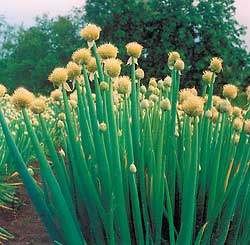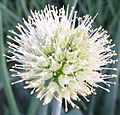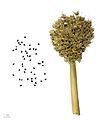Welsh onion facts for kids
Allium fistulosum, also known as the Welsh onion, is a type of plant that grows year after year. It's often thought of as a kind of scallion. You might also hear it called bunching onion, long green onion, Japanese bunching onion, or spring onion.
Quick facts for kids Welsh onion |
|
|---|---|
 |
|
| Allium fistulosum at a farm | |
| Scientific classification | |
| Genus: |
Allium
|
| Species: |
fistulosum
|
| Synonyms | |
|
|
| Nutritional value per 100 g (3.5 oz) | |
|---|---|
| Energy | 142 kJ (34 kcal) |
|
6.5 g
|
|
| Sugars | 2.18 g |
| Dietary fiber | 2.4 g |
|
0.4 g
|
|
|
Protein
|
1.9 g
|
| Vitamins | Quantity
%DV†
|
| Thiamine (B1) |
4%
0.05 mg |
| Riboflavin (B2) |
8%
0.09 mg |
| Niacin (B3) |
3%
0.4 mg |
| Pantothenic acid (B5) |
3%
0.169 mg |
| Vitamin B6 |
6%
0.072 mg |
| Folate (B9) |
4%
16 μg |
| Vitamin C |
33%
27 mg |
| Vitamin E |
3%
0.51 mg |
| Vitamin K |
184%
193.4 μg |
| Minerals | Quantity
%DV†
|
| Calcium |
5%
52 mg |
| Iron |
9%
1.22 mg |
| Magnesium |
6%
23 mg |
| Manganese |
7%
0.137 mg |
| Phosphorus |
7%
49 mg |
| Potassium |
7%
212 mg |
| Sodium |
1%
17 mg |
| Zinc |
5%
0.52 mg |
|
Link to USDA Database entry
|
|
| †Percentages estimated using US recommendations for adults. | |
This plant tastes and smells a lot like a regular onion, Allium cepa. Sometimes, these two plants even mix to create new types, like tree onions. But unlike common onions, the Welsh onion doesn't grow a big round bulb. Its leaves and stems are hollow, which is why it's called fistulosum (meaning "hollow").
Some larger Welsh onions look like leeks, such as the Japanese negi. Smaller ones look more like chives. Welsh onions can grow in groups that stay green all year. They are also grown just for their beauty as an ornamental plant.
Contents
What's in a Name?
The name "Welsh onion" can be a bit confusing. It doesn't mean the onion comes from Wales. Instead, "Welsh" used to mean "foreign" or "not from here." This plant actually comes from China. It's now grown in many places and grows wild in parts of Europe, Asia, and North America.
In the past, A. fistulosum was called the "cibol." In Cornwall, a region in England, people sometimes call them "chibbles."
The Welsh onion isn't native to Wales and isn't a big part of Welsh cuisine. The plant commonly found in Wales is the leek, which is the national vegetable of Wales.
Other common names for this plant include green onion, salad onion, and spring onion. These names can be tricky because they are also used for any young green onion stalk. This includes those grown from regular onions or other similar plants in the Allium family.
How People Use Welsh Onions
Welsh onions are a popular ingredient in Asian cuisine, especially in East Asia and Southeast Asia. They are very important in China, Japan, and Korea. This is why they are sometimes called Japanese bunching onions.
In Western countries, Welsh onions are mostly used as scallions or salad onions. But in other parts of the world, especially East Asia, they are used in many more dishes.
Jamaican Cooking
In Jamaican cuisine, Welsh onions are called "escallion." They are often used with thyme, scotch bonnet pepper, garlic, and allspice (which Jamaicans call pimento). Some recipes suggest using leeks instead of escallion in salads. You can also buy dried spice mixes in stores that contain escallion.
The name "escallion" likely comes from "scallion." This term is used broadly for spring onions and other similar plants in the Allium family.
Japanese Cooking
In Japan, the Welsh onion is called negi (葱). This name can also refer to other plants in the Allium family. More specifically, it's called naganegi (長葱), which means "long onion." Regular onions came to East Asia in the 1800s. However, the Welsh onion is still more popular and widely used.
It's used in many dishes like miso soup and negimaki (beef and scallion rolls). It's also often sliced and used as a topping for dishes like teriyaki or takoyaki.
-
Duck soba with negi
Korean Cooking
In Korea, the Welsh onion is called pa (파), meaning "scallion." Regular onions are called yangpa (양파), meaning "Western scallion."
Larger types of Welsh onions, which look a bit like leeks, are called daepa (대파), or "big scallion." Thinner, younger ones are called silpa (실파), or "thread scallion." Another similar plant, the A. × proliferum, is called jjokpa (쪽파).
Both daepa and silpa are used as a spice, herb, or garnish in Korean cuisine. The white part of daepa is often used to flavor broths and oils. The green part of silpa is often used as a garnish.
Dishes using daepa include pa-jangajji (pickled scallions) and pa-mandu (scallion dumplings). Pa-sanjeok is skewered beef and scallions. Padak is a type of Korean fried chicken topped with shredded raw daepa.
Dishes using silpa include pa-namul (seasoned scallions) and pa-jangguk (scallion beef-broth soup). Pa-ganghoe are parboiled scallion rolls where silpa is used to tie other ingredients together.
-
Pa-namul (seasoned blanched scallions)
-
Pa-muchim (seasoned shredded scallions) eaten with samgyeopsal (grilled pork belly)
-
Pa-sanjeok (skewered beef and scallions)
Russian Cooking
In Russia, Welsh onions are used in the spring. People add their green leaves to fresh salads.
Images for kids
See also
 In Spanish: Cebolla blanca para niños
In Spanish: Cebolla blanca para niños












